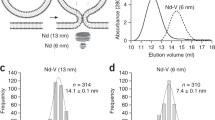Abstract
Sarcoplasmic reticulum (SR) membrane vesicles have been prepared from rabbit skeletal muscle and solubilised using K+ cholate. Solubilised membrane proteins were reconstituted into small asolectin liposomes by dialysis against cholate-free solution. Large liposomes were produced by freezing and thawing at −80°C and room temperature, respectively. The liposomes were assayed for the SR K+ channel using the patch clamp technique. Channel density was modulated by varying protein: lipid ratios during reconstitution. Channels inserted into the membrane with a preferred orientation. The solubilised and reconstituted channel behaves ohmically over the holding potential range ±70 mV and has a conductance of 178.4±4.4 pS (mean ± SE,n=37) in 200 mM KCl. The channel has a selectivity sequence of K+>NH +4 >Rb+>Na+ and K+ conductance is blocked by hexamethonium and decamethonium. The opening probability of the reconstituted channel is voltage dependent. The conductance and gating characteristics displayed by the solubilised and reconstituted channel correlate well with those previously observed following the fusion of native SR membrane vesicles with planar phospholipid bilayers.
Similar content being viewed by others
References
Agnew WS, Levinson SR, Brabson JS, Raftery MA (1978) Purification of the tetrodotoxin binding component associated with the voltage-sensitive sodium channel fromElectrophorus electricus electroplax membranes. Proc Natl Acad Sci USA 75:2606–2610
Anholt R, Fredkin DR, Deerinck T, Ellisman M, Montal M, Lindstrom J (1982) Incorporation of acetylcholine receptors into liposomes. J Biol Chem 257:7122–7134
Barchi RL, Cohen SA, Murphy LE (1980) Purification from rat sarcolemma of the saxitoxin-binding component of the excitable membrane sodium channel. Proc Natl Acad Sci USA 77:1306–1310
Bell JE, Miller C (1984) Effects of phospholipid surface charge on ion conduction in the K+ channel of sarcoplasmic reticulum. Biophys J 45:279–287
Bensadoun A, Weinstein D (1976) Assay of proteins in the presence of interfering materials. Anal Biochem 70:241–250
Corey DP, Stevens CF (1983) Science and technology of patch-recording electrodes. In: Sakmann B, Neher E (eds) Single channel recording. Plenum Press, New York, pp 53–68
Coronado R, Miller C (1980) Decamethonium and hexamethonium block K+ channels of sarcoplasmic reticulum. Nature 288:495–497
Coronado R, Rosenberg RL, Miller C (1980) Ionic selectivity, saturation and block in a K+-selective channel from sarcoplasmic reticulum. J Gen Physiol 76:425–446
Ehrenstein G, Lecar H (1977) Electrically gated ionic channels in lipid bilayers. Q Rev Biophys 10:1–34
Fox JA (1985) Conductance and selectivity properties of a substate of the rabbit sarcoplasmic reticulum channel. Biophys J 47:573–576
Garcia AM, Miller C (1984) Channel mediated monovalent cation fluxes in isolated sarcoplasmic reticulum vesicles. J Gen Physiol 83:819–839
Hartshorne R, Catterall W (1984) The sodium channel from rat brain: purification and subunit composition. J Biol Chem 259:1667–1675
Huganir R, Racker E (1982) Properties of proteoliposomes reconstituted with acetylcholine receptor fromTorpedo californica. J Biol Chem 257:9372–9378
Kasahara M, Hinkle PC (1977) Reconstitution and purification of thed-glucose transporter from human erythrocytes. J Biol Chem 252:7384–7390
Labarca P, Coronado R, Miller C (1980) Thermodynamic and kinetic studies of the gating behaviour of a K+-selective channel from the sarcoplasmic reticulum membrane. J Gen Physiol 76:397–424
Labarca P, Lindstrom J, Montal M (1984) Acetylcholine receptors in planar lipid bilayers. J Gen Physiol 83:473–496
McKinley D, Meissner G (1978) Evidence for a K+, Na+ permeable channel in sarcoplasmic reticulum. J Membr Biol 44:159–186
Meissner G, McKinley D (1982) Permeability of canine cardiac sarcoplasmic reticulum vesicles to K+, Na+, H+ and Cl−. J Biol Chem 257:7704–7711
Miledi R, Molinoff P, Potter LT (1971) Isolation of the cholinergic receptor protein ofTorpedo electric tissue. Nature 229:554–557
Miller C (1978) Voltage-gated cation conductance channel from fragmented sarcoplasmic reticulum. Steady state electrical properties. J Membr Biol 40:1–23
Miller C (1982) Bis-quaternary ammonium blockers as structural probes of the sarcoplasmic reticulum K+ channel. J Gen Physiol 79:869–891
Miller C (1983) Integral membrane channels: studies in model membranes. Physiol Rev 63:1209–1242
Miller C (1984) Ion channels in liposomes. Ann Rev Physiol 46:549–558
Nelson N, Anholt R, Lindstrom J, Montal M (1980) Reconstitution of purified acetylcholine receptors with functional ion channels in planar lipid bilayers. Proc Natl Acad Sci USA 77:3057–3061
Rosenberg RL, Tomiko SA, Agnew WS (1984) Single-channel properties of the reconstituted voltage-regulated Na+ channel isolated from the electroplax ofElectrophorus electricus. Proc Natl Acad Sci USA 81:5594–5598
Schindler H, Spillecke F, Neumann E (1984) Different channel properties ofTorpedo acetylcholine receptor monomers and dimers reconstituted in planar membranes. Proc Natl Acad Sci USA 81:6222–6226
Tank DW, Miller C (1983) Patch-clamped liposomes; recording reconstituted ion channels. In: Sakmann B, Neher E (eds) Single channel recording. Plenum Press, New York, pp 91–105
Tank DW, Miller C, Webb WW (1982) Isolated-patch recording from liposomes containing functionally reconstituted chloride channels fromTorpedo electroplax. Proc Natl Acad Sci USA 79:7749–7753
Tank DW, Huganir RL, Greengard P, Webb WW (1983) Patch-recorded single-channel currents of the purified and reconstitutedTorpedo acetylcholine receptor. Proc Natl Acad Sci USA 80:5129–5133
Tomlins B, Williams AJ, Montgomery RAP (1984) The characterisation of a monovalent cation-selective channel of mammalian cardiac muscle sarcoplasmic reticulum. J Membr Biol 80:191–199
Weigele JB, Barchi RL (1982) Functional reconstitution of the purified sodium channel protein from rat sarcolemma. Proc Natl Acad Sci USA 79:3651–3655
Young RC, Allen R, Meissner G (1981) Permeability of reconstituted sarcoplasmic reticulum vesicles. Reconstitution of the K+, Na+ channel. Biochim Biophys Acta 640:409–418
Author information
Authors and Affiliations
Rights and permissions
About this article
Cite this article
Tomlins, B., Williams, A.J. Solubilisation and reconstitution of the rabbit skeletal muscle sarcoplasmic reticulum K+ channel into liposomes suitable for patch clamp studies. Pflügers Arch. 407, 341–347 (1986). https://doi.org/10.1007/BF00585312
Received:
Accepted:
Issue Date:
DOI: https://doi.org/10.1007/BF00585312




